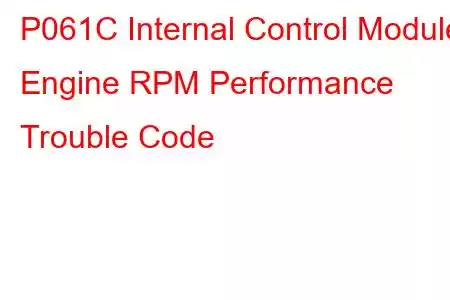P061C Internal Control Module Engine RPM Performance
OBD-II Trouble Code Technical Description
Internal Control Module Engine RPM Performance
What does that mean?
This generic powertrain diagnostic trouble code (DTC) typically applies to many OBD-II vehicles. That may include but is not limited to vehicles from Dodge, Ram (Cummins), Ford, Chrysler, etc.
When a code P061C is stored, it means that the powertrain control module (PCM) has detected an internal performance error in the engine RPM (revolutions per minute) monitoring system. Other controllers may also detect an internal PCM performance error (with the engine RPM monitoring system) and contribute to a P061C being stored.
Internal control module monitoring processors are responsible for various controller self-test duties and overall internal control module accountability. Engine RPM calculation system input and output signals are subject to self-test and are monitored constantly by the PCM and other related controllers. The transmission control module (TCM), traction control module (TCSM), and other controllers are subject to interaction with the engine RPM monitoring system.
Engine RPM is monitored (by the PCM and other controllers) using input signals from the crankshaft position (CKP) sensor and the camshaft position (CMP) sensor/s. Desired engine RPM is programmed into the PCM and other controllers. Actual RPM is calculated using input data from the CKP and CMP sensors, as well as the throttle position sensor (TPS), and other engine and transmission sensors. Desired RPM is then compared with actual RPM.
Whenever the ignition is on and the PCM is energized, internal engine RPM monitoring self-tests are initiated. In addition to running internal controller self-tests, the controller area network (CAN) also compares signals from each individual module to ensure that all controllers are functioning properly. These tests are performed simultaneously.
If the PCM detects an internal error in desired engine RPM and actual RPM (which exceeds the maximum allowable threshold), a code P061C will be stored and a malfunction indicator lamp (MIL) may be illuminated. Multiple ignition cycles (with a failure) may be required for MIL illumination.
Photo of a PCM with the cover removed:
What is the severity of this DTC?
Internal control module processor codes should be categorized as severe. A stored code P061C could result in serious drivability and fuel efficiency issues, suddenly and without warning.
What are some of the symptoms of the code?
Symptoms of a P061C trouble code may include:
Hesitation or stumble upon acceleration Engine misfire Diminished fuel efficiency Engine misfire codes may also be presentWhat are some of the common causes of the code?
Causes for this code may include:
Defective CKP/CMP sensor Oil contaminated CKP/CMP sensor connector Defective PCM or PCM programming error Open or shorted circuit or connectors in the CAN harness Insufficient control module ground Open or shorted circuits between the CKP/CMP sensor/s and the PCMWhat are some P061C troubleshooting steps?
Even to the most experienced and well-equipped professional technician, diagnosing a code P061C can prove to be quite a challenge. There is also the issue of reprogramming. Without the necessary reprogramming equipment, it will be impossible to replace a defective controller and complete a successful repair.
If there are ECM/PCM power supply codes present, they will obviously need to be rectified before attempting to diagnose a P061C. Also, if there are CKP/CMP sensor or throttle position sensor (TPS) codes present, these must be diagnosed and repaired first.
Follow manufacturer's recommendations for testing CKP, CMP, and TPS sensors. The oscilloscope can be particularly helpful when testing electromagnetic sensors.
Read: 43


